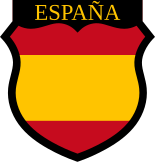Blue Legion
| Spanish Volunteer Legion | |
|---|---|
 Insignia of the Blue Legion, incorporating the flag of Spain | |
| Active | 17 November 1943 – 12 April 1944 |
| Country | |
| Allegiance | |
| Branch | |
| Type | Infantry |
| Size | 2,133–3,000 troops |
| Nickname(s) | Blue Legion |
| Commanders | |
| Notable commanders | Miguel Ezquerra |
The Blue Legion (Spanish: Legión Azul; German: Blaue Legion), officially called the Spanish Volunteer Legion (Spanish: Legión Española de Voluntarios; German: Spanische-Freiwilligen Legion), was a volunteer legion created from 2,133 falangist volunteers who remained behind at the Eastern Front after most of the Spanish Blue Division was withdrawn in October 1943 because Francisco Franco had started negotiations with the Allies. It officially consisted of two battalions. It was later estimated that the legion grew to over 3,000 Spaniards.[citation needed]
The 101st SS Spanish Volunteer Company (German: Spanische-Freiwilligen Kompanie der SS 101) of 140 men, composed of four rifle platoons and one staff platoon, was attached to the 28th SS Volunteer Grenadier Division Wallonien (the Walloon Legion) and fought in Pomerania and Brandenburg. Later, as part of 11th SS Volunteer Panzergrenadier Division Nordland and under command of Hauptsturmführer der SS Miguel Ezquerra, it fought during the last days of the war against Soviet troops in the Battle of Berlin.[1]
The troops bore the word ESPAÑA and a red/yellow/red horizontally striped shield worn on the upper right arm, and a helmet.
References[]
- ^ Julio, Rodriguez-Puértolas (2008). Historia de la literatura fascista española. p. 712.
- Military unit and formation stubs
- Foreign volunteer units of the Wehrmacht
- Military units and formations established in 1943
- Military units and formations disestablished in 1944
- Expatriate units and formations
- Military units and formations of the Soviet–German War
- Military history of Spain